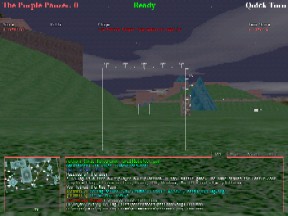 |
 |
I first discuss some design principles I like to incorporate, then there are sections for each of the downloadable maps. At the beginning is a summary table with all of them listed and available for download, if you'd like to skip the descriptions.
Here are the sections below:
| Table of Contents | |
| 2.1 All of the Maps | A table with downloads for all of the maps. |
| 2.2 Design Principles | Some brief comments on map design. |
| 2.3 Ionian Pathways | My first Version 2 map, with highways, a temple, and hills. |
| 2.4 ContestFFA | The gold-medal winner from the 2004 map contest |
| 2.5 Contest CTF | My capture-the-flag map from the same contest |
| 2.6 Collaborator 1 | Four map makers did this together, one for each quarter. |
| 2.7 First Map: Two Fortresses | My very first BZFlag map: two castles in opposite corners. |
| 2.8 Borg Cube | My 2nd map, a Borg cube up in space, with nearby starships. |
| 2.9 Valley of the Dammed | A lake with a dam, and a hollow mountain. |
| 2.10 MadCity Extended | The original MadCity increased in size with new buildings. |
| 2.11 MadCity Reflected | A mirror image of the original (modified) MadCity. |
| 2.12 MiniMap | An experiment in making a smaller map. |
| 2.13 Minas Tirith | A 1st draft of a Minas Tirith/Minas Ithil/Minas Morghul map. |
| 2.14 Wild West map | A very large map with scattered towns, like the Great Plains. |
| 2.15 The Two Towers | Two vertical structures for inter-building fighting. |
| 2.16 UnitBlocks | A map based on multiples of a basic size, like kids' blocks. |
| 2.17 Arena | A very sparse map for two players, done by request. |
| 2.18 Other Designs | Some notes on possible designs. |
For convenience, here are all of the maps described below:
| Name | File | BZFlag Version targetted |
| Ionian Pathways | Ionian.zip | 2.0 |
| ContestFFA | ContestFFA.bzw | 1.10.2 |
| ContestCTF | ContestCTF.bzw | 1.10.2 |
| Two Fortresses | firstmap.zip | 1.10.2 |
| Borg Cube | borgmap.zip | 1.9 (probably OK for later versions) |
| Valley of the Dammed | valley.zip | 1.10.2 |
| (Original Madcity - not mine) | MadCity.zip | 1.10.2 |
| Big MadCity | bigmadcity.zip | 1.10.2 |
| MadCity Reflected | MirrorMadCity.zip | 1.10.2 |
| MiniMap | MiniMap.zip | 1.10.2 |
| Minas Tirith | minastirith.zip | 1.10.4 |
| Wild West map | HugeMap.map | 1.10.6 |
| Two Towers | TwoTowers.map | 1.10.6 |
| Unit Blocks | UnitBlocks.map | 1.10.6 |
| Arena | Arena.bzw | 1.10.4 |
I've played on a variety of maps, many of which are excellent; one of my favorites is a modified form of the modified MadCity map, available here in zip format (while I had nothing to do with writing it or making the later modifications, I want to help make it widely available). I believe that the original MadCity was by someone known as Grape of Wrath; this was then modified and ran on the Turkey.Moongroup server and Hashmark, among others. (Below I present a 600x600 size map which extends the modified version of MadCity; see section 2.4)
From it and other maps I've distilled a few principles I like to see in maps:
1. Commonality of heights: for every position at a particular level, there is another within range to allow attack. This doesn't have to be uniformly true by any means; but if it is rarely true, it's hard to fight well without special flags.
2. "Neighborhoods": rather than a map of uniform (or similar) structure over its entire playable area, it is more fun to have different distinct parts of the map, with different aesthetics, advantages, and disadvantages. This lets you pick your ground based on your mood, your flag, or teaming opportunities.
3. Enabling powerful flags: I like maps which have sweet spots for tanks with particular weapons. There shouldn't be too many, but if you grab a Laser flag, or a Guided Missile flag, it's fun to be able to milk all of the advantage out of it you can before your (inevitably short) run with it ends. These positions should be flawed, so that they're not impregnable. (More on this in the section "Thoughts on the Game" .)
4. The map should be interesting and rewarding to explore, but not so complicated that it cannot be understood roughly equally by new players on the map and those with more experience.
This is my first map using the new features available in version 2, and it may be downloaded here: Ionian.zip. It has several novel features: Gaussian hills, Highways, and a Greek temple. I named it Ionian Pathways because I really focused on various routes through the map, rather than on creating particular neighborhoods (though those are certainly there). It is quite open, which would be great for Laser.
 |
 |
The highways in this map let you move quickly from one part of the map to the other; each highway has two lanes, going in opposite directions, which move you quite rapidly if you get up on them.
The Gaussian hills are mainly for eye appeal and laser ricochet; they are pretty easy to go down, almost impossible to go up.

This was the gold medal winner in the 2004 Map Design Contest, see for example http://www.cruzan.info/bzflag/2004.html. You may download it here: ContestFFA.bzw
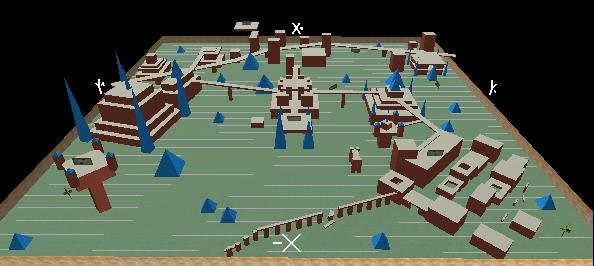
Here are some excerpts from the description I submitted with the map:
This map was inspired by footage of the fighting in Fallujah - the houses, narrow streets, and primitive architecture seemed like they'd be excellent themes in a map. The "Fallujah" here is fairly small and in one corner, but it is particularly difficult to fight in - while it seems easy to just fire shots into buildings, in this town the probability of a ricochet killing you is quite high. There are vertical ways out of buildings too, so kills aren't quite so easy anyway. This ancient town has a partly damaged aqueduct leading into it, and an ancient triumphal arch near where the city wall once was. Modern buildings have intruded though, generally taking heights up one or two levels; from these buildings an elevated road network runs to different points on the map. This road network is one main theme of the map.
The more general theme in the map is having distinct "neighborhoods", areas which visually feel different and which call for different tactics in fighting. There is quite a lot of open space, requiring old-fashioned tank vs. tank maneuvering. The number of neighborhoods means that this map will be good for more players, 8 being fine; more could certainly play. There are only 337 blocks and pyramids, so lag shouldn't be a problem.
A note about some of the taller pyramids: a number of them are specifically designed to allow players to ricochet shots into upper levels from the ground; this isn't trivial to do, but with a little practice some of the more useful angles should become clear. A few pyramids are drivethrough but not shootthrough, so that you can get into them and hide - these usually have nonstandard shape so that you can pick them out.
The large amound of "green" open space will require traditional skills for much of the time. Camping is certainly possible, but that will require some thought on behalf of the camper and any would-be camper killers; I think this is definitely part of the fun. No positions are invulnerable, all should have designed-in routes for camper hunters.
Ten teleporters mean that you can move around pretty quickly, rapidly changing your environment; indeed, you can get to most surfaces and levels without jumping (if you're willing to drive distances, and occasionally drop down to other levels). In one place I've connected two tall towers with a *very* thin block, intended to be something fun to discover.
One of my long-time favorite maps is "modified Madcity", and I paid homage to that map by including a tower similar to the central tower in that map - I intend this as a recognizable element, akin to a literary reference in a novel, rather than as a central tactical or strategic object - in this map it is on the northern edge, and therefore won't play as much of a role as it does in Madcity. I don't think this tower is exactly identical to the Madcity one, but it's certainly close enough to be recognizable.
In the southeast is a structure that looks like the Madcity "garage", but it isn't - it evolved from a quite different direction, and has no internal structure on its second level; and it is much smaller. One part of the elevated roadway was inspired by something similar in the Bessler's World map; other than that, everything is entirely original (and even the derivative elements are used in new ways).
Finally, fundamentally this is sort of a classic style of map, basic in spirit, with no use of novelty features (with the exception of the few drivethrough pyramids and the thin threadlike block linking towers - elements which aren't at all new); I stayed away from hidden drivethrough passages, teleporters as combat shields, exaggerated vertical structures, world weapons, and other mechanisms for increasing complexity. Though it was written for this contest, it should feel like a map that could have been around for some time. As the BZFlag map elements will shortly be changing quite a bit, I expect future maps to be dramatically different - this is likely the last map of this style that I write. As such, I thought it ought to show what can be done with these simple components, simply arranged.
This map didn't do as well in the contest, but I think it has one novel central idea that makes it worthwhile. I wrote about this some time ago on this page, speculating as follows:
Although I don't play much Capture the Flag, I've thought of an idea I'd like to try for a map. The map would have different isolated playing areas (either on the surface, or on platforms up in the air). These areas (probably 10 to 15 or so) would be connected in a simple topology: a team base at either end of this web of areas, the web providing pathways for reaching the opposite team's flag (two pathways are shown in the diagram )
Note that this is a logical layout, not a physical one. The physical implementation might look very much like an ordinary map, but certain areas would be reachable only via particular pathways. The number of pathways probably has to depend on the number of players; but three would allow some strategic thinking (e.g. "Let's fake a strong assault up the left side, and when the other team commits forces, we'll strike on the right".) More intricate topologies would be possible to allow supporting tanks to move in, but this would require larger teams.
Each node would be a battleground: for a team to move to the opposite team's area, it would have to conquer each of the intervening nodes along at least one path. These should be well-defined battles, perhaps with each area having a distinct flavor. The two bluish nodes in the diagram above are intended as augmented defensive positions, possibly platforms above the team and close-in nodes to allow last-ditch defensive support.
So now here is such a map: ContestCTF.bzw
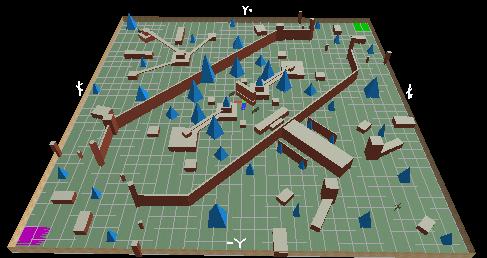
Here is my description from the contest submission:
This is my second (and therefore last) map for this contest, a Capture-The-Flag map for two teams. The key idea in this map is something that I don't believe I've ever seen in a CTF map before. This one main idea is key to understanding and playing the map; I will start by describing it in a basic form, then explain how a more interesting variant is presented here. The larger goal of the concept is to encourage more team cooperation and communication - these are necessary here to win.
This map has the bases in opposite corners, and three main and separate paths to get from one base to the other: centrally along the diagonal, up across the top of the map, or down across the bottom of the map. In its simplest form (without teleporters) once you choose one of these paths, which start close to the bases, you can't change - the paths only intersect near the bases. Teams must choose on which paths they will
concentrate strength, and then commit to those decisions (the only alternative being a local defense of their base, which is no way to win). Once the tanks are out on one of the paths, the only way to get to another path is either to go back to their base or on to the enemy's base.
What this means is that one team can locally overwhelm the other team on one of the three routes - which results in a controlling a route to capture the enemy's flag and get home. The remaining two routes need some form of minimal defense, but a small, well-organized team may quite readily beat a bigger team. It is a matter of planning and communication; certainly luck (say with spawn locations) will play a part, but assessing the enemy's intentions and coordinating an offense will give a team a substantial advantage. As a side note, this also changes the importance of certain flags - Stealth for instance can give you a strategic as well as tactical advantage, as your team may move to dominate a path without tipping its hand.
The three paths have different playing styles - the bottom one is more open, the top has some vertical options, and the center one is more like street fighting; a team could pick its favorite. In the top and bottom routes there are good defensive positions near the chokepoints at each base, while the central path is designed for a good fight over the central teleporters. All of this is probably clearer if you view the map in BZEdit or Observer mode in BZFlag, and get up high.
I wanted to allow a little more fluidity in play than 3 isolated routes would provide, so I did provide some interconnection. In the center of the map (in the middle route) are teleporters to the top and bottom routes (and one can get in to the center from those other paths as well). Topologically, it's as if you took the symbol for infinity and drew a horizontal line through the middle - three routes to the left from the center to the purple base, and three routes to the right leading to the blue base (in fact this map started as such a network diagram). This makes the center of significant strategic and tactical value - a team controlling it can shift strength to the flanks as needed. It's like controlling the center of a chessboard - you can set the agenda, and keep the opponent on the defensive. This also means that the top and bottom paths have a
midpoint worthy of control - the teleporter location, out near the non-base corners - an area sometimes of little interest in diagonal maps.
The map is completely symmetric - both sides see the same effective half-map leading to the center, so it is completely fair. As there are three separate main paths, it would be particularly good for a large number of players (say, 9 or more on a team). If the tanks are too sparse (e.g. 3 on a team) the strategic logic may be blurred by the tactical exigencies that arise, and the value of the map will be less clear. There are 75 boxes, 39 pyramids, and 4 teleporters, for a total of 118 objects which need rendering - lag should not be an issue even for a lot of users.
As I use the name "The Purple Panzer", I wanted one of the teams to be purple; the other is blue, simply because I don't see it all that much on servers. (As the documentation seemed to be contradictory, the bzfs qualifier I use is "-mp 0,0,0,4,4,4", setting 4 blue, 4 purple, and 4 observers, 4 just for my testing purposes - higher is better.)
My name for the map is "BZ Pharoah", as if you view the map with BZEdit, rotate it a little and put it at a distance, the map seems to be a sort of stylized Pharonic face. Most of this pattern emerged naturally from the design constraints - it was only when it was nearly complete that the image become apparent.
You can read about the Collaborator Project at Shellshock; I was one of the four designers for the first project. You may download the map by clicking here: collaborator1.zip. Here's an overview of what the map looks like:
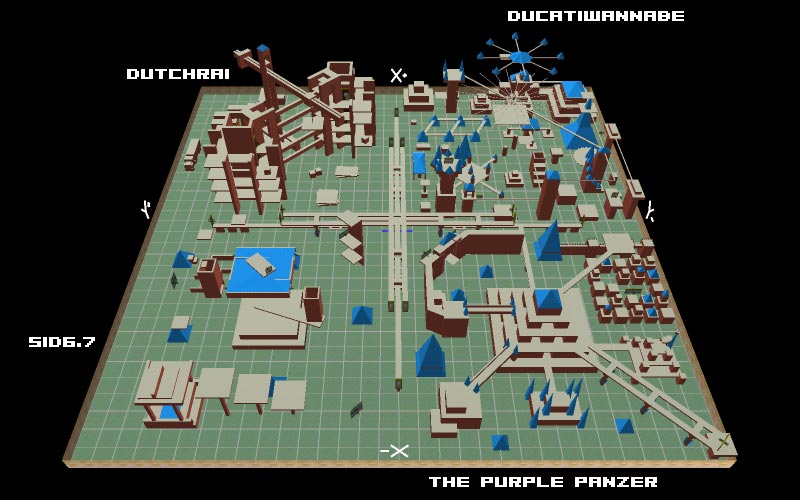
For my first map, I created two fortresses in opposite corners, with different aesthetics. You my download it in zip format by clicking here.
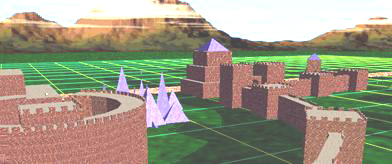 One fortress has crenellated towers, and looks vaguely like Windsor
Castle, with a large round tower. In the very corner of the map is a
building with a teleporter, which will take you to a floating platform above
one flank of the fortress. To enter this fortress, you must either leap
the walls between crenels, or drive through a large arched entrance (or leap
from a siege tower positioned outside the walls).
One fortress has crenellated towers, and looks vaguely like Windsor
Castle, with a large round tower. In the very corner of the map is a
building with a teleporter, which will take you to a floating platform above
one flank of the fortress. To enter this fortress, you must either leap
the walls between crenels, or drive through a large arched entrance (or leap
from a siege tower positioned outside the walls).
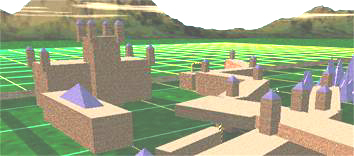 The second fort is a bit simpler, but has connections out to outlying
towers. Aesthetically it is much less ornate. Its main entrance is
easily defended by firing shots through a one-way teleporter, and its walls
are too high to leap upon from the ground. Teleporters allowing access
to the inside of the fort are vulnerabilities; inside, the main structure is a
parliamentary building.
The second fort is a bit simpler, but has connections out to outlying
towers. Aesthetically it is much less ornate. Its main entrance is
easily defended by firing shots through a one-way teleporter, and its walls
are too high to leap upon from the ground. Teleporters allowing access
to the inside of the fort are vulnerabilities; inside, the main structure is a
parliamentary building.
In the middle map is a town/village, set in a stream of pyramids, which loosely partition the map into two halves. In the corners opposite the fortresses are relatively open spaces with a few structures (including a sort of modernized Roman fort, partially roofed to provide protection from Guided Missile attacks.

I think that this map provides a variety of playing challenges, and generally fits the principles above. It is simple enough to be understood quickly, but some of the platform height and distance combinations are a bit subtle. I have yet to be able to host this on a server which can be accessed from outside of my LAN, and I'd very much appreciate it if someone would; I think actually watching play on it will highlight good and bad points, and possibly lead to modifications.
(Already, we've noticed some lag with this map, possibly because of details such as the crennels; so I've created a pared-down version, Two Fortresses Light, which you can get by clicking here.
The idea for this hit me in an instant, and it took a fairly short time to create it. The central theme is that players fight inside a 3D cube suspended in space, modeled very loosely on craft of the "Star Trek: The Next Generation" enemy known as the Borg.
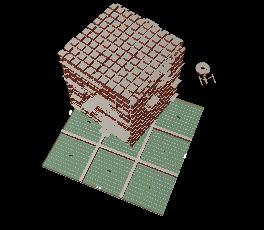 You start out ("spawn") on the ground, in one of a small number of
squares with teleporters in them; each of these teleporters is connected to a
teleporter inside the cube. This means that you really can't fight very
much on the ground at all.
You start out ("spawn") on the ground, in one of a small number of
squares with teleporters in them; each of these teleporters is connected to a
teleporter inside the cube. This means that you really can't fight very
much on the ground at all.
Inside the cube are a number (25, I think) of levels (or floors); each only partially covers that slice through the cube, so it is relatively easy to jump up to the next level or fall through to a lower level. Vertical walls and pyramids interrupt each floor, so that you may well have to move in three dimensions to get from one place to another. When driving, it is almost as easy to go up and down as it is to move on the horizontal. Teleporters inside the cube let you move around from point to point fairly quickly.
Outside of the cube there are several NCC 1701 class starships, which are useful to jump to.
Tactically, this is a very different sort of map - you have to think and move in the full three dimensions, and the radar isn't particularly good for estimating vertical distances. It changes the flag/weapon utilities too: Shockwave is excellent, Guided Missile quite limited, and Oscillation Overthruster just drops you a long way down.
Beware that it is a computationally expensive world to run: I expect not so much because of the number of objects (which isn't that large), but because at any one time there are many more objects in the field of view than with usual surface maps.
I think of this world as mainly an interesting experiment, certainly worth exploring, but probably hard to play in without a decent server and good video cards in the clients. It is fun though. To download it in zip format, click here.
This was a simple idea to start with; it grew a bit, until I decided to try to keep to a strict blockcount limit. This one is sort of a combination of the underlying concepts of the above two maps: it is very playable and relatively simple, but with a lot of vertical play. You may download it (zipped) by clicking here.

The hill on the right side is hollow; players may get in via teleporter or "caves" in the cliff faces (think of Qumran). I put a number of pyramids inside that cavern to prevent spawning there - sort of a waste, but there really isn't any other way to do it.
If you get into the "water" behind the dam, it can get a little disorienting - I tried to make it so. Some fighting may take place entirely underwater.
I've created a 600 x 600 version of MadCity, with the central 400x400 being the unchanged original (modified) madcity. I first extended the roads, etc. in obvious directions, then tried to add new neighborhoods in the spirit of the map. There are only 427 blocks & pyramids in it, which is a good thing given the size (600x600=360,000 in area, vs. 400x400=160,000, that is, this new map has more than twice the area of the original).

You may download it by clicking here: bigmadcity.zip
I've played a lot on the MadCity map, and at times it seems just too familiar. So I've created a mirror image of it, which of course has all of the same tactical opportunities as the original, but is sufficiently different that it's refreshing. You may download it by clicking here: MirrorMadCity.zip
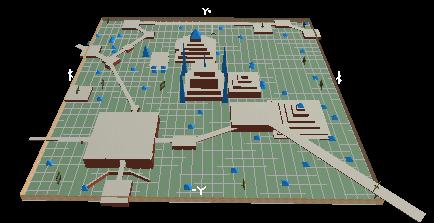
It is quite fun to play on if you're used to MadCity, as everything is familiar, but in an inverse sort of way - kind of like something out of a dream. It reminded me very much of when I first played on MadCity, and didn't know it so well - some of my memories of first perceptions came back to me.
With the version 1.10, it has been possible to change the world size. I used this to create the larger MadCity map above, with for each coordinate runs from -600 to 600, instead of the standard -400 to 400. I thought I'd try to create a smaller one, which you may download here: MiniMap.zip.
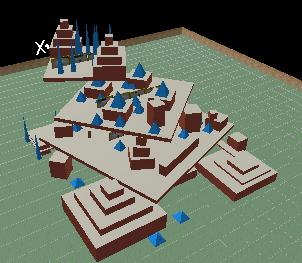 This map has X and Y coordinates which range from -150 to 150, so it is
significantly smaller than most standard maps. I've added three playing
levels above the base field, so it isn't quite as tiny as it might seem,
although it is still small compared to standard maps.
This map has X and Y coordinates which range from -150 to 150, so it is
significantly smaller than most standard maps. I've added three playing
levels above the base field, so it isn't quite as tiny as it might seem,
although it is still small compared to standard maps.
On each level are teleporters to take you to the other levels. A convention is used: the taller the teleporter, the higher the level it takes you to; this sizing convention is the same on all levels, and the teleporters always appear in the same relative positions (in a line). So you can tell without much thought where you'll end up. The only oddity is the teleporter which takes you to the level you're already on - this is rigged as a mirror, so that it might be tactically useful when firing and jumping.
You may also climb to several of the levels without using the teleporters, so if you have Stealth you can sneak up on someone at another level. And, as a final note: the world does look interesting from the tallest towers on the top level.
The idea for this map was to represent the valley between the 7-layered city of Minas Tirith and Minas Ithil (Minas Morgul) from The Lord of the Rings.
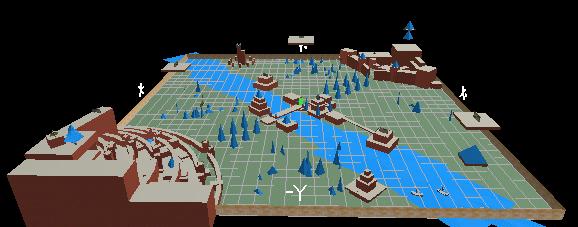
In the center, running diagonally, is the river Anduin, and the small town of Osgiliath. In one corner is Minas Tirith, with the seven circles of walls, and the tree at the top. In the other corner is the large Black Gate and a fairly stylized representation of Minas Morgul. Off to one side (not strictly correct in Middle Earth) is the spire of Orthanc at Isengard; a teleporter links it to Mordor. There is something like an evil eye in the sky over Mordor, which you can get to if you find the right teleporter. The map is here: minastirith.zip.
This is a very large map, an experiment in using wide-open spaces. The best way to think about it is that there are several towns scattered about a large plain. In the center of each town is a teleporter, which will take you to the next (or previous) town - this is the way to move about quickly if you need to cover a lot of space.
My hope was that each town could become a battleground by itself, and that moving between towns would almost feel like moving between servers. The map is here: HugeMap.map.
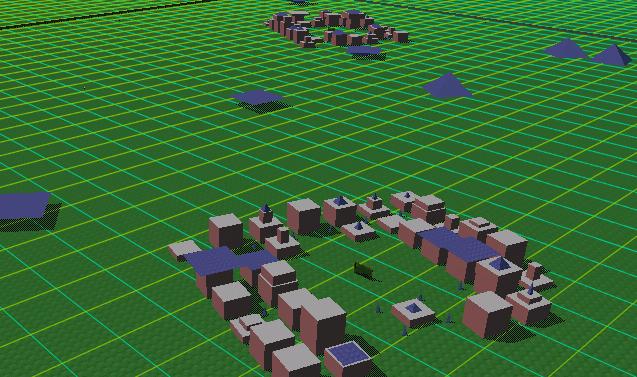
This picture only shows two of the six towns, but you get an idea of the amount of space present. While I've enjoyed playing on it, scattering a few more teleporters around in a way to allow quick intuitive guessing of where they might take you would help the play a bit. It really does have a different feel right now though, soothing in a way. You may get it by clicking here: HugeMap.map.
 This is another experiment in very vertical fighting; think of it as two
skyscrapers, with fighting going on between them (sort of like the opening to
Monty Python's Life of Brian).
This is another experiment in very vertical fighting; think of it as two
skyscrapers, with fighting going on between them (sort of like the opening to
Monty Python's Life of Brian).
Each tower is make up of three-floor cells. Within a cell you move between floors by jumping; between cells you use teleporters. The taller teleporter will take you up, the shorter one down.
The map is here: TwoTowers.map.
As BZFlag sometimes reminds me of the blocks and toy tanks that kids play with, I thought it'd be interesting to build a map using the unit blocks idea, where each block dimension is an integral multiple of some basic size. This Unit Blocks map is the result.
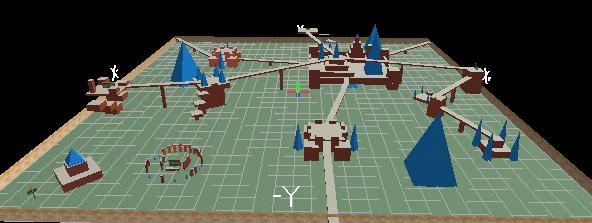
I didn't stick with this idea entirely, first because it obviously isn't the most efficient way to build a structure - when my son builds with blocks, he can use may of them to make up what would be single larger one in BZflag. Beyond that, I wanted to toss in some additional elements, notably a representation of Stonehenge as it looks now.
This map is really pretty simple and small, but has a lot of play opportunities. Try it and let me know what you think: UnitBlocks.map.
This map was done at a server owner's request (Jules the Jackal). He wanted something very simple for a one-on-one fight (that is, the server would only allow two players), loosely patterned after the old Star Trek episode in which Captain Kirk battles the Gorn commander (a lizard-like creature). Note the U.S.S. Enterprise floating above the battlefield, which one could reach via teleporter.

To download it, click on: Arena.bzw
I've also thought about using registration points to help make crazy ricochet shots possible. Each registration point might be a small box up in the air which you could see on radar; you drive under it, and line up (possibly the box points, or there is a second box or pyramid further along, sort of like a gunsite). When you fire, the bullet may do quite a few ricochets before hitting a pre-determined place (perhaps a doorway, teleporter, or camper site).
The way to put these in is to work backwards, shooting from the target spot and seeing where the bullet goes. I expect it'll be something of an iterative process to get things just right, but it might add a lot of fun to the game. Particularly, I could imagine a map where using such registration points is virtually the only way to hit the enemy.